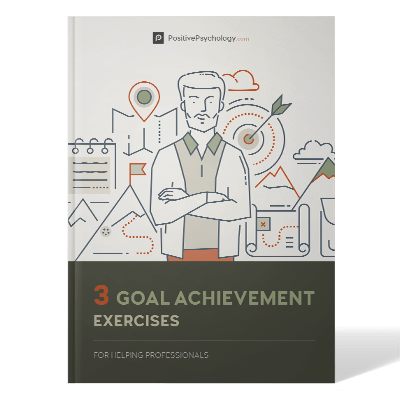17 Motivation Worksheets, Exercises & Activities (+ PDF)
 One size does not fit all when it comes to motivation, so we will often find that we have to try new techniques, new mindsets, and new approaches in our search for that perfect ensemble.
One size does not fit all when it comes to motivation, so we will often find that we have to try new techniques, new mindsets, and new approaches in our search for that perfect ensemble.
All the same, it’s good to have a few tricks up our sleeve, whether trying to motivate ourselves or someone on our team, classroom, or at home.
Hard work beats talent when talent doesn’t work hard.
Tim Notke
This article is a form of motivation toolbox that contains several motivational activities and worksheets as well as suggestions (new and old) for how to intervene in our motivational states.
Before you continue, we thought you might like to download our three Goal Achievement Exercises for free. These detailed, science-based exercises will help you or your clients create actionable goals and master techniques to create lasting behavior change.
This Article Contains:
Motivation Worksheets
In our search for the just-right recipe for motivation, we need to understand first what motivates us. We begin with awareness building tools in the form of questionnaires.
The first worksheet will help us assess the satisfaction of basic psychological needs. Then we will move to the exploration of our mechanisms that support or thwart motivation. We will explore our self-esteem and take an inventory of our curiosity before we dive into what else might get in the way and cause us to procrastinate.
Once equipped with a good map of our current motivational needs, we move on to interventions that help alter our emotional states toward the positive and bring on a sense of wellbeing, which can be used to increase our motivation toward goal pursuit.
Basic Psychological Need Satisfaction in General (Deci & Ryan, 2000; Gagné, 2003)
According to the self-determination theory, the needs for competence, autonomy, and relatedness must be continually satisfied for people to develop and function in healthy and optimal ways (Deci & Ryan, 2000).
Please read each of the following items carefully, thinking about how it relates to your life, and then indicate how true it is for you. Use the following scale to respond:
| Statements | not al all true | somewhat true | very true | ||||
|---|---|---|---|---|---|---|---|
| 1. I feel like I am free to decide for myself how to live my life. | 1 | 2 | 3 | 4 | 5 | 6 | 7 |
| 2. I really like the people I interact with. | 1 | 2 | 3 | 4 | 5 | 6 | 7 |
| 3. Often, I do not feel very competent. | 1 | 2 | 3 | 4 | 5 | 6 | 7 |
| 4. I feel pressured in my life. | 1 | 2 | 3 | 4 | 5 | 6 | 7 |
| 5. People I know tell me I am good at what I do. | 1 | 2 | 3 | 4 | 5 | 6 | 7 |
| 6. I get along with people I come into contact with. | 1 | 2 | 3 | 4 | 5 | 6 | 7 |
| 7. I pretty much keep to myself and don’t have a lot of social contacts. | 1 | 2 | 3 | 4 | 5 | 6 | 7 |
| 8. I generally feel free to express my ideas and opinions. | 1 | 2 | 3 | 4 | 5 | 6 | 7 |
| 9. I consider the people I regularly interact with to be my friends. | 1 | 2 | 3 | 4 | 5 | 6 | 7 |
| 10. I have been able to learn interesting new skills recently. | 1 | 2 | 3 | 4 | 5 | 6 | 7 |
| 11. In my daily life, I frequently have to do what I am told. | 1 | 2 | 3 | 4 | 5 | 6 | 7 |
| 12. People in my life care about me. | 1 | 2 | 3 | 4 | 5 | 6 | 7 |
| 13. Most days I feel a sense of accomplishment from what I do. | 1 | 2 | 3 | 4 | 5 | 6 | 7 |
| 14. People I interact with on a daily basis tend to take my feelings into consideration. | 1 | 2 | 3 | 4 | 5 | 6 | 7 |
| 15. In my life I do not get much of a chance to show how capable I am. | 1 | 2 | 3 | 4 | 5 | 6 | 7 |
| 16. There are not many people that I am close to. | 1 | 2 | 3 | 4 | 5 | 6 | 7 |
| 17. I feel like I can pretty much be myself in my daily situations. | 1 | 2 | 3 | 4 | 5 | 6 | 7 |
| 18. The people I interact with regularly do not seem to like me much. | 1 | 2 | 3 | 4 | 5 | 6 | 7 |
| 19. I often do not feel very capable. | 1 | 2 | 3 | 4 | 5 | 6 | 7 |
| 20. There is not much opportunity for me to decide for myself how to do things in my daily life. | 1 | 2 | 3 | 4 | 5 | 6 | 7 |
| 21. People are generally pretty friendly towards me. | 1 | 2 | 3 | 4 | 5 | 6 | 7 |
Scoring information: Form three subscale scores, one for the degree to which the person experiences satisfaction of each of the three needs. To do that, you must first reverse score all items that are worded in a negative way shown below with (R) following the items numbers.
To reverse score an item, simply subtract the item response from 8. Thus, for example, a two would be converted to a 6. Once you have reverse scored the items, average the items on the relevant subscale:
Autonomy: 1, 4(R), 8, 11(R), 14, 17, 20(R)
Competence: 3(R), 5, 10, 13, 15(R), 19(R)
Relatedness: 2, 6, 7(R), 9, 12, 16(R), 18(R), 21
The Rosenberg Self-Esteem Scale (Rosenberg, 1965)
The scale is a ten-item Likert scale with items answered on a four-point scale – from strongly agree to strongly disagree.
Instructions: Below is a list of statements dealing with your general feelings about yourself. If you strongly agree, circle SA. If you agree with the statement, circle A. If you disagree, circle D. If you strongly disagree, circle SD.
| Statements | Strongly Agree | Agree | Disagree | Strongly Disagree |
|---|---|---|---|---|
| On the whole, I am satisfied with myself. | SA | A | D | SD |
| *At times, I think I am no good at all. | SA | A | D | SD |
| I am able to do things as well as most other people. | SA | A | D | SD |
| I feel that I have a number of good qualities. | SA | A | D | SD |
| * I certainly feel useless at times. | SA | A | D | SD |
| * I feel I do not have much to be proud of. | SA | A | D | SD |
| I feel that I’m a person of worth, at least on an equal plane with others. | SA | A | D | SD |
| * I wish I could have more respect for myself. | SA | A | D | SD |
| * All in all, I am inclined to feel that I am a failure. | SA | A | D | SD |
| I take a positive attitude toward myself. | SA | A | D | SD |
Scoring: SA=3, A=2, D=1, SD=0. Items with an asterisk are reverse scored, that is, SA=0, A=1, D=2, SD=3. Sum the scores for the ten items. The higher the score, the higher the self-esteem. We also discuss the Rosenberg Self-esteem Scale with questionnaires in detail in our blog.
Curiosity Inventory
Curiosity has been positively linked to intrinsic motivation and is considered by some a vital psychological mechanism for achieving more of it. Trait curiosity and exploration inventory designed by Kashdan to measure our inclination to inherently rewarding pursuits. Curiosity has been linked to many health and social benefits (2009).
Rate the following statements on how they describe how you generally feel:
| Statements | Extremely Characteristic | Moderately Characteristic | Neutral | Moderately Uncharacteristic | Extremely Uncharacteristic |
|---|---|---|---|---|---|
| 1. I actively seek as much information as I can in a new situation. | 1 | 2 | 3 | 4 | 5 |
| 2. I am the type of person who really enjoys the uncertainty of everyday life. | 1 | 2 | 3 | 4 | 5 |
| 3. I am at my best when doing something challenging and complex. | 1 | 2 | 3 | 4 | 5 |
| 4. Everywhere I go I am looking for new things and experiences. | 1 | 2 | 3 | 4 | 5 |
| 5. I view challenging situations as an opportunity to grow and learn. | 1 | 2 | 3 | 4 | 5 |
| 6. I like to do things that are a little bit frightening | 1 | 2 | 3 | 4 | 5 |
| 7. I am always looking for experiences that challenge how I think about myself and the world. | 1 | 2 | 3 | 4 | 5 |
| 8. I prefer jobs that are excitingly unpredictable. | 1 | 2 | 3 | 4 | 5 |
| 9. I frequently seek out opportunities to challenge myself and grow as a person. | 1 | 2 | 3 | 4 | 5 |
| 10. I am the kind of person who embraces unfamiliar people, events, and places. | 1 | 2 | 3 | 4 | 5 |
Procrastination Scale (Lay, 1986)
Students may use the following statements to describe themselves. For each statement, decide whether the statement is uncharacteristic or characteristic of you using the following 5-point scale.
Note that the three on the scale is Neutral – the statement is neither characteristic nor uncharacteristic of you. To the right of each statement, write the number on the 5-point scale that best describes you.
| Statements | Extremely Characteristic | Moderately Characteristic | Neutral | Moderately Uncharacteristic | Extremely Uncharacteristic |
|---|---|---|---|---|---|
| 1. I often find myself performing tasks that I had intended to do days before. | 1 | 2 | 3 | 4 | 5 |
| 2. I do not do assignments until just before they are to be handed in. | 1 | 2 | 3 | 4 | 5 |
| 3. When I am finished with a library book, I return it right away regardless of the date it is due. | 1 | 2 | 3 | 4 | 5 |
| 4. When it is time to get up in the morning, I most often get right out of bed. | 1 | 2 | 3 | 4 | 5 |
| 5. A letter may sit for days after I write it before mailing it. | 1 | 2 | 3 | 4 | 5 |
| 6. I generally return phone calls promptly. | 1 | 2 | 3 | 4 | 5 |
| 7. Even with jobs that require little else except sitting down and doing them, I find they seldom get done for days. | 1 | 2 | 3 | 4 | 5 |
| 8. I usually make decisions as soon as possible. | 1 | 2 | 3 | 4 | 5 |
| 9. I generally delay before starting on work I have to do. | 1 | 2 | 3 | 4 | 5 |
| 10. I usually have to rush to complete a task on time. | 1 | 2 | 3 | 4 | 5 |
| 11. When preparing to go out, I am seldom caught having to do something at the last minute. | 1 | 2 | 3 | 4 | 5 |
| 12. In preparing for some deadline, I often waste time by doing other things. | 1 | 2 | 3 | 4 | 5 |
| 13. I prefer to leave early for an appointment. | 1 | 2 | 3 | 4 | 5 |
| 14. I usually start an assignment shortly after it is assigned. | 1 | 2 | 3 | 4 | 5 |
| 15. I often have a task finished sooner than necessary. | 1 | 2 | 3 | 4 | 5 |
| 16. I always seem to end up shopping for birthday or Christmas gifts at the last minute. | 1 | 2 | 3 | 4 | 5 |
| 17. I usually buy even an essential item at the last minute. | 1 | 2 | 3 | 4 | 5 |
| 18. I usually accomplish all the things I plan to do in a day. | 1 | 2 | 3 | 4 | 5 |
| 19. I am continually saying I will do it tomorrow | 1 | 2 | 3 | 4 | 5 |
| 20. I usually take care of all the tasks I have to do before I settle down and relax for the evening. | 1 | 2 | 3 | 4 | 5 |
Note: Reversed-keyed items: 3,4,6,8,11,13,14,15,18,20
Changes in emotion and perceptions of wellbeing can be used as feedback in the effort to motivate others in productive ways. Several subjective experiences of wellbeing can be achieved through practicing gratitude, cultivation of hope through visualization, or through learning to exercise one’s strengths. These, in turn, can be used to support increased motivation and produce a gradual change in behavior.
Here are some examples of worksheets used by Robert Biswas-Diener as tools for increasing positive emotions and cognitions from his manual for coaching positive psychology. These are prime examples of intervention that alter emotional states toward the positive or re-frame our way of thinking toward the more optimistic end of the spectrum.
Happiness is liquid
Happiness is liquid, in the same way, that monetary instruments such as stocks are liquid. Humans are built with emotional systems that include the capacity for happiness. It is a type of emotional currency that can be spent, like money, on the outcomes in life we truly value, such as our health, our relationships, and success at work.
One way to appreciate the existing wealth we all possess is to notice and magnify moments when we either receive from or give kindness to others.
Reflect on the following questions:
- Who acknowledged you today?
- How did it feel when you were acknowledged? Try visualizing that moment.
- What else would you like to be acknowledged for?
- Who had a hand in the day’s greatest successes?
- Who rose to the occasion?
- Who took initiative?
- Who offered support?
- How were these people acknowledged?
- How does it make you feel when you think of these things?
- What does it make you feel like doing?
Coaching Questions for the Ideal Self
Reflect on the image of your ideal self by answering the following questions. This can be done in the form of powerful open-ended questioning during a coaching session or assigned as a writing exercise.
- How well articulated is the ideal self?
- How important is it to you to achieve the ideal self?
- When are you planning to make the changes associated with achieving the ideal self?
- What resources and opportunities do you have that will help you work toward your ideal self?
- What hurdles do you anticipate? How can these be part of the growth process?
- What factors inform your vision of your ideal self?
- How internal (as opposed to external) are the values that inform your ideal self?
- What person, living or dead, is similar to your ideal self?
- Name a single, small behavior you can change as the first step toward your ideal self.
- How can you chart your progress toward your ideal self?
Creating an ideal self-imagine in the future
It may be the near future or several years from now. Imagine this is a future in which you have gotten many of the things you want from life and accomplished many of the things to which you aspire.
Take a couple of minutes to picture what you are like and what your life is like. Imagine where you would be living, where you would be working. Imagine what your commute is like, your health is like, your friendships are like. Imagine the skills you have and the opportunities you have for growth.
Picture the types of decisions you have made and the goals you have achieved.
This can be done in the form of powerful open-ended questioning during a coaching session or assigned as a writing exercise.
- Describe where would you be living.
- What is it you value in living arrangements and circumstances that you would like to achieve?
- To what extent is this vision of your future living arrangements internal versus the product of some external factor or someone else’s values?
- Describe your work life: your commute, your office, your position, the type of work you would do.
- What is it you value in work that you would like to achieve in this ideal future?
- To what extent is this vision of your future work the product of internal versus the product of some external factor or someone else’s values?
Now that the client has a vision of a desired future, we can help him or her move toward goal setting.
Setting SMART+R Goals
Setting SMART+R Goals offers a different take on SMART goals that assigns more importance to indicators of making progress and measuring progress against specific targets.
This flow also incorporates room for scheduled rewards, to encourage positive reinforcement when a target is reached.
Another way to track progress would be to use technology. Feedback tracking technologies have been designed to help address progress feedback.
The pursuit of quantifiable objectives often guides our lives. When something gets in the way of sustaining the motivation necessary for achieving those goals, we can use self-tracking technologies to motivate ourselves and others.
Goal progress feedback with valences and visualization features can influences commitment and persistence across a broad range of domains, including physical tasks and purchasing behaviors, according to recent data from social and consumer psychology research.
Here is a quick list of what’s out there:
Building New Habits
Implementation Intentions, also known as ‘If, then‘ plans can be very helpful in planning for all the eventualities when something gets in the way of achieving our goals. Normally we would brainstorm ahead of time to have a back-up plan for when known detractors get in the way of getting things done.
We suggest that occasionally, we introduce a reward into this plan of action to even further motivate persistence on goal. This Building New Habits exercise helps you do this by working through the three steps of The Habit Loop: cue, behavior, and reward.
Motivational Activities

One model of goal setting conversation is the Auerbach GOOD coaching model (2015). It can be used for structuring coaching sessions in a way that progresses from goal setting and exploring options to action planning and accountability.
Auerbach GOOD coaching model:
Goals – define the most important goals a client wants to work toward
Options – explore option is available to help them move forward
Obstacles – name obstacles that might get in the way of progress
Do – specify what is the client going to do specifically and by when
To expand on these steps of the GOOD model, here are questions you can ask at each stage and all while practicing empathy, active listening, and providing support.
Goal phase:
- What is a goal you want to focus on?
- When you are successful with this goal, what will it look like?
- What makes this goal important to you?
- How does this goal fit into your vision?
- When you reach your desired outcome, how would you like to feel?
- What type of change would make your life even better?
Options phase:
- What is some way your goal could be accomplished?
- Tell me about a time you accomplished something similar?
- What ways have you seen others approach such a task?
- What action can you take to achieve your goal?
- If you choose not to take some of the actions, what will be the impact?
Obstacles phase:
- What could get in the way of you moving forward with pursuing your goal?
- What external challenges might interfere?
- What internal challenges might get in the way?
- Who can you get support from?
Do phase:
- What strategies are you willing to employ to reach your objective?
- What specifically are you going to do, and when?
- How will you know you’re making progress?
- What is the most immediate action you can take, and when?
- How long will it take, and when will you complete it?
Work-style scale questionnaire
Designed to distinguish four distinct types of motivational approaches to work: procrastinators, incubators, planners, and triflers (Biswas-Diener, 2010).
4= perfectly describes me
3= describes me somewhat
2= does not describe me
1= does not describe me at all
A= I always get my work completed on time
B= The quality of my work is superior
C= It takes a looming deadline to motivate me
D= I do my best work under pressure
E= I like to get started on the project right away
Use the following description to score the work-style questionnaire by looking for the following constellations of high scores:
Planners: are self-motivated, strategize their work, and tend to start right away even on the long-term project. Planners generally score high on items A, B, and E.
Incubators: thrive on deadlines, put off work till the last minute but always complete work on time, and produce high quality. Incubators generally score high on items A, B, C, and D.
Triflers: start work early but get distracted and lose interest easily. Triflers generally score high on item E and low on items A and B.
Procrastinators: put off work till the last minute and often hand in mediocre work. Procrastinators generally score high on items C and D and low on items A and B.
FLOW questionnaire
Intrinsically motivating activities can be identified through the experience sampling method originally used by Csikszentmihalyi to identify the states of flow (1990). The below questionnaire can help clients understand how they allocate attention throughout the day and if they spend a lot of time investing their energy effectively.
This should be done over at least a week but preferably two. Ask the client to set their phone to prompt him or her during the day at random times to notice what they are doing and jot down the answers to the following questions:
- At this moment, what are you doing, and who are you with?
- How satisfied are you on a scale of 1 to 10?
- How much skill is needed for this activity? Choose one:
- No skills needed
- Some skills required
- A moderate amount of skills used
- Had to stretch to do this activity
- Describe your level of motivation
- Doing this because you have nothing else to do
- Doing this because I am told to
- Doing this because I have to
- Doing this because I want to
- How challenged are you by the activity on a scale of 1 to 10?
- How much are you concentrating on a scale of 1 to 10?
A recent study where subjects were asked to deliberately not engage in intrinsically motivating activities showed a decrease in the sense of wellbeing in just two days (Pink, 2009).
Path that’s right for me
Using strengths, according to Govinji and Linley leads to wellbeing and vitality and promotes self-efficacy and believing that you can accomplish your goals (2007). Here is a questionnaire their study was based on, followed by reflection questions about using strengths in a new way which often leads to better progress toward goals:
- I am regularly able to do what I do best
- I always play to my strengths
- I always try to use my strengths
- I achieve what I want by using my strengths
- I use my strengths every day
- I use my strengths to get what I want every day
- My work gives me a lot of opportunities to use my strengths
- My life presents me with a lot way to use my strengths
- Using my strengths comes naturally to me
- I find it easy to use my strengths in the things I do
- I am able to use my strengths in a lot of different situations
- Most of my time is spent doing things I am good at doing
- Using my strengths is something I am familiar with
- I am able to use my strength in a lot of different ways
Here are questions that can be used for reflecting on leveraging strengths toward goal pursuit:
- What are some new ways in which you can use strengths?
- What strengths are you using today?
- How can you spend more time this week doing things that you are good at?
- How can you use your strengths this week to achieve your goal?
Neuro-linguistic programming (NLP)
Although the methods themselves have not been scientifically tested, some of the techniques used by the neuro-linguistic programming (NLP) have shown to be effective in increasing positive emotional states and can be linked to well-known psychological phenomena.
NLP has been used to increase self-awareness and to help spot negative patterns, thoughts, and assumptions that may be worth replacing. We discuss two commonly used NLP methods below; first to alter emotional states toward the positive in the moment, and the second to combat thoughts that trigger anxiety by visualizing alternative responses.
Anchoring technique is based on the psychological concepts of operant conditioning, where a stimulus triggers specific responses that were conditioned through repetition. The goal of the practice is to learn to elicit positive emotional responses at will so one can use them as needed. Anchoring is intended to improve our ability to control emotions and allows us to take an active role in self-regulation.
How to use the anchoring technique:
- Bring to mind a memory of the time you felt really good where you experienced intense positive feelings you want to trigger in other situations (e.g., feeling achievement the moment you got a promotion).
- Try to remember details of what you saw, felt, smelt, and heard to bring in sensory cues associated with that memory and to intensify it to be as vivid as possible.
- At this point, associate your feelings to an anchor, which could be a gesture of any kind like twisting a ring on your finger or pinching your earlobe, for example.
- Take a short break and repeat the steps above.
- Test the anchor by performing the action and observe if it elicits the positive feelings.
- You can then use this method whenever you need an emotional pick-me-up.
The Swish Method attempts to identify mental and emotional triggers of negativity and replace them with a typical response.
In this technique, you don’t have to take any action but become aware of the alternatives available to you in terms of how you respond to negative thoughts and emotions.
Driven by the principle that seeing is believing, the Swish Method is a visualization technique based on the assumption that our mind often does not differentiate between real and visualized events, as they both activate the same parts of the brain.
How to put the Swish Method into action:
- Identify a thought and the associated feelings that usually trigger anxiety for you. You’re about to deliver a speech and feel nervous and uneasy.
- Notice how your mind and body react. This can be a sensation of butterflies in your stomach or brain fog.
- Bring to mind a visual image of the context in which this happens. This could be as you walk into the room or get up to the podium.
- Think about how you would ideally like to respond as you physically enter the context in which the negative thoughts take place. You may choose to be calm, confident, well-prepared, optimistic, etc.
- This will become your replacement thought. In your mind, visualize the negative state and figuratively place the replacement thought over it, make sure it appears bigger, stronger, and more vibrant while making the negative emotion appear in black and white or blurry.
- You will need to practice the Swish Method a few times to ensure the replacement thought becomes the default response. Do it at least five times and speed up the visualization with each round. To check for effectiveness, evoke the trigger thought/feeling and its context, and see how you feel about it.
Oblique Strategies

Oblique Strategies (subtitled Over One Hundred Worthwhile Dilemmas) is a card-based method for promoting creativity designed by Brian Eno and Peter Schmidt, first published in 1975.
Here are examples of these statements:
- Don’t be afraid of things because they’re easy to do.
- Honor thy error as a hidden intention.
- Turn it upside down.
- Go slowly all the way round the outside.
- Make a sudden, destructive unpredictable action; incorporate.
- What is the reality of the situation?
- Look closely at the most embarrassing details and amplify them.
- You can only make one dot at a time.
- Are there sections? Consider transitions.
- Infinitesimal gradations.
- Ask your body.
- Look at the order in which you do things.
- What are you really thinking about just now? Incorporate.
- Use unqualified people.
- Disconnect from desire.
- Into the impossible.
- Work at a different speed.
- Discover the recipes you are using and abandon them.
- Make an exhaustive list of everything you might do and do the last thing on the list.
- Do nothing for as long as possible.
- Accretion.
- Humanize something free of error.
- Define an area as ‘safe’ and use it as an anchor.
- Emphasize repetitions.
- Take away the elements in order of apparent non-importance.
- Ask people to work against their better judgment.
- Listen to the quiet voice.
- Trust in the you of now.
- Abandon normal instruments.
- Repetition is a form of change.
- Make a blank valuable by putting it in an exquisite frame.
- The inconsistency principle.
- Not building a wall but making a brick.
- Faced with a choice, do both.
- Be less critical more often.
Motivation Board

Some call it a vision board, and it is basically a visual incentive that can help you find excitement and enthusiasm through pictures of what you want, making it harder to ignore than words. It should be placed somewhere where you can see it every day because out of sight is out of mind.
Other Visual aids such as drawing, video recordings, viewing images of others accomplishing what you want to accomplish are all powerful tools to make your subconscious mind aligned with your conscious desire.
Motivation and Meditation
Practicing meditation can help increase and sustain motivation toward goal pursuit. Meditation helps with concentration and allows us to stay focused for longer. Meditation also reduces stress as it promotes relaxation. Meditation improves cognition and increases the ability to perform tasks that requires focus. Meditation allows us to become more aware of our emotions.
Meditation, when practiced for as little as 10 minutes per day, can help clear the mental clutter that distracts us from our goal, not to mention decrease anxiety and improve our cardiovascular health.
There are many guided meditations that target specific outcomes: learning relaxation, practicing focus and concentration, reducing stress, rumination, anxiety, and chronic pain, cultivating self-awareness and body awareness as well as insight meditation for practicing acceptance.
Many can be downloaded as an app or found on websites, meditative music playlists, podcasts, videos, blogs, and for those who are so inclined, nature is always a great option. There are courses and classes on meditation, both online and in-person, offered through local providers and even employers.
Ironically enough, many complain about not being able to find the motivation to meditate as there are some preconceived notions about the amount of effort required. It is often best to start small with something readily available, perhaps as a replacement of something that may not be the best use of our time, like browsing the social media while waiting for the next appointment.
Motivational Questions

They are always open-ended and often thought-provoking.
They are a well-known tool for any coach and, when expertly used, can be quite effective as a motivational technique at any point and in most situations.
It is a skill that requires some practice; however, empowering questions is rarely something we learn at home or school.
- What value does this goal represent to you?
- How will you celebrate your victory?
- How would that contribute to the world?
- What about this goal demonstrates what you stand for?
- What keeps you going?
- What really excites you about that?
- What about this goal fits into your purpose?
- What part of this relates to your dreams?
- If you had all the time, energy and money to achieve your goals, what would you do?
- Why is that important to you?
- What do you want to experience?
- What works well?
- What’s another way to look at that?
- How can you reframe that to help you move on?
- How will you demonstrate motivation and perseverance?
Motivation Courses
Many coaching programs offer mastery courses, and it is often a part of the curriculum to teach self-mastery to coaches who impart their knowledge to their clients. Courses on motivation are also offered as online courses through:
- Udemy
- Courser
- Skillashare
And if you’re overwhelmed with choices offered through these platforms, you can go to Class Central website to see a complete list of MOOC courses.
You can also enroll in a personal mastery program, and some of the well-known institutions that offer those are:
- Sounds true
- Mindvalley
- The Rao Institute
There are also several Mastery Programs for teens. Those are most effective as in-person after school or summer camp type programs that allow the teens to develop self-mastery through activities that:
- Give Responsible Tasks
- Work in Groups
- Positive Competition
- Evaluation Programs
- Switch Roles
- Field Trips
Finally, there are many ways to hold Team building activities for employees. From local providers to HR or employee organized events, at the office or off-site, team building has been used to bond, promote collaboration, and spread fun through the office.
Some companies like Atlassian take team building to the next level. They use innovation fairs where teams go offsite and am given all the beer and chocolate cake they can handle, as long as they originate, develop, and deliver new products, new services, or business process improvements overnight.
Motivational Quotes
Men’s best successes come after their disappointments.
Henry Ward Beecher
Do not wait to strike till the iron is hot; but make it hot by striking.
William B. Sprague
Motivation is a fire from within. If someone else tries to light that fire under you, chances are it will burn very briefly.
Stephen R. Covey
Success is not the key to happiness. Happiness is the key to success. If you love what you are doing, you will be successful.
Albert Schweitzer
Desire is the starting point of all achievement, not a hope, not a wish, but a keen pulsating desire which transcends everything.
Napoleon Hill
You can have anything you want if you are willing to give up the belief that you can’t have it.
Robert Anthony
Great spirits have always encountered violent opposition from mediocre minds.
Albert Einstein
When you want to succeed as bad as you want to breathe, then you’ll be successful.
Eric Thomas
A man can be as great as he wants to be. If you believe in yourself and have the courage, the determination, the dedication, the competitive drive and if you are willing to sacrifice the little things in life and pay the price for the things that are worthwhile, it can be done.
Vince Lombardi
The question isn’t who is going to let me; it’s who is going to stop me.
Ayn Rand
Motivation Resources
Our suggestion for creating a toolbox of motivational resources would be to take the time to try out a few motivational strategies and choose a few that can be used in the moment as well as some that are more appropriate for long term goal setting, as well as cultivating motivational muscle and investing in the future ability to find motivation at will.
In the moment strategies could include:
- Music
- Affirmations
- Anchoring
Long term motivation
- Ideal future-self visualization
- Explore strengths and use them in novel ways
- Find moments of flow through ESM method to get straight to intrinsic motivation
Investment in the future of growing the motivational muscle:
- Assess the satisfaction of psychological needs
- Hire a coach
- Take a motivational course or mastery modeling program
While the suggestions for how to get motivated abound, the actual value of motivational tools comes from learning to use them and use them well.
I suppose it is tempting, if the only tool you have is a hammer, to treat everything as if it were a nail.
Abraham Maslow
The law of the instrument, otherwise known as Maslow’s hammer, remind us that we have a cognitive bias to over-rely on a familiar tool.
If you’re looking for more science-based ways to help others reach their goals, this collection contains 17 validated motivation & goals-achievement tools for practitioners. Use them to help others turn their dreams into reality by applying the latest science-based behavioral change techniques.
A Take-Home Message
The irony in writing this article was trying to find the motivation to do it. Because having learned a lot about it was a small part of the process. We all know how to live our lives well, yet few of us can bring ourselves to do it. Although it is important to understand what motivation is, ultimately, it is much more important to experience what motivation does.
Do you have a favorite motivational strategy or technique? Please share it with us here.
We hope you enjoyed reading this article. Don’t forget to download our three Goal Achievement Exercises for free.
- Auerbach, J. E. (2015). Positive Psychology in Coaching. Pismo Beach, CA; Executive College Press.
- Biswas-Diener, R. (2016, September). Role of emotions in coaching. Paper presented at the ICF Advance: Science of Coaching conference, Phoenix, AZ.
- Carver, C. S., & Scheier, M. F. (1990). Origins and functions of positive and negative affect: a control-process view. Psychological Review, 97(1), 19-35
- Crandal, R. (1973). The measurement of self-esteem and related constructs, Pp. 80-82 in J.P. Robinson & P.R. Shaver (Eds), Measures of social psychological attitudes. Revised edition. Ann Arbor: ISR. Rosenberg, M. (1965). Society and the adolescent self-image. Princeton, NJ: Princeton University Press. Wylie, R. C. (1974). The self-concept. Revised edition. Lincoln, Nebraska: University of Nebraska Press.
- Deci, E. L., & Ryan, R. M. (2000). The “what” and “why” of goal pursuits: Human needs and the self-determination of behavior. Psychological Inquiry, 11, 227-268.
- Deci, E. L., Ryan, R. M., Gagné, M., Leone, D. R., Usunov, J., & Kornazheva, B. P. (2001). Need satisfaction, motivation, and well-being in the work organizations of a former Eastern Bloc country. Personality and Social Psychology Bulletin, in press.
- Gagné, M. (2003). The role of autonomy support and autonomy orientation in prosocial behavior engagement. Motivation and Emotion, 27, 199-223.
- Ilardi, B. C., Leone, D., Kasser, R., & Ryan, R. M. (1993). Employee and supervisor ratings of motivation: Main effects and discrepancies associated with job satisfaction and adjustment in a factory setting. Journal of Applied Social Psychology, 23, 1789-1805.
- Kasser, T., Davey, J., & Ryan, R. M. (1992). Motivation, dependability, and employee supervisor discrepancies in psychiatric vocational rehabilitation settings. Rehabilitation Psychology, 37, 175-187.
- Lay, C. (1986). At last, my research article on procrastination. Journal of Research in Personality, 20, 474-495.
- Locke, E., & Latham, G. (2002). Building a practically useful theory of goal setting and task motivation: A 35-year odyssey. American Psychologist, 57(9), 705-717.
- Thogersen-Ntoumani, C., Ntoumanis, N., Cumming, J., & Chatzisarantis, N. L. D. (2011). When feeling attractive matters too much to women: A process underpinning the relation between psychological need satisfaction and unhealthy weight control behaviors. Motivation and Emotion, 35, 413–422.
Let us know your thoughts
Read other articles by their category
- Body & Brain (41)
- Coaching & Application (49)
- Compassion (27)
- Counseling (46)
- Emotional Intelligence (23)
- Gratitude (16)
- Grief & Bereavement (19)
- Happiness & SWB (35)
- Meaning & Values (26)
- Meditation (21)
- Mindfulness (42)
- Motivation & Goals (42)
- Optimism & Mindset (33)
- Positive CBT (24)
- Positive Communication (21)
- Positive Education (41)
- Positive Emotions (28)
- Positive Psychology (33)
- Positive Workplace (38)
- Relationships (31)
- Resilience & Coping (33)
- Self Awareness (21)
- Self Esteem (38)
- Software & Apps (23)
- Strengths & Virtues (28)
- Stress & Burnout Prevention (27)
- Theory & Books (42)
- Therapy Exercises (30)
- Types of Therapy (53)




What our readers think
A very nice different and varied work sheets about problem -solving skills this. I appreciate this. thanks a lot.
thank you for motivational activities articles and motivational worksheet. I feel happy to study about these .your tasks appreciated.
Thank you Ms. Souders for this informative article. It has set me to explore new areas that I did not know earlier . The quotes are insightful. The ones that inspired me the most are:
Hard work beats talent when talent doesn’t work hard.-Tim Notke
Do not wait to strike till the iron is hot; but make it hot by striking.-William B. Sprague
You motivated me to start Positive Psychology classes 🙂 , thanks a lot for your sincerity and efforts.
What a insightful reading especially at the begging of the year as the Student counselor . i will have a great guide how to motivate them
Thankyou, what a thorough, insightful read. It is so useful to me, Thankyou, much appreciated!
Thank you for this thorough, comprehensive, easy to read exposition. I appreciate your generosity in sharing the tools, worksheets, and activities, and thus aiding us to be proponents of positive psychology.